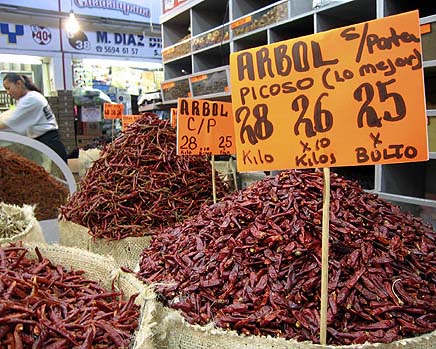Forget the mild life -- pepper fans can't get enough of hot chilies
By Gwen Schoen (SACRAMENTO, Calif.)
Updated: 2006-07-21 16:56
 |
Large Medium Small |
 Chili-heads have no sympathy for those of us who live in fear of the hot pepper.
Chili-heads have no sympathy for those of us who live in fear of the hot pepper.
While blinking back tears, mopping sweaty brows and reaching for tissues to dab at their noses, they croak their insults and boast of their conquests.
"Only a wimp takes out the seeds," says Margaret Watson Hopkins of Rancho Murieta
"My motto is, if it doesn't work with a hot pepper, it's not food," says Elizabeth Weintraub of Land Park. "I've been known to eat peppers so hot that nothing would help, not milk or even bread. The only thing I could do was stand over the kitchen sink and drool into it."
"I'm a hottie," says Pattee Thorpe of Rocklin. "I eat hot peppers on everything: cereal, popcorn, ice cream. Once I was in a specialty food shop in Virginia where the owner was offering hot peppers to sample. He said the peppers were so hot that we had to sign a waiver stating we wouldn't sue him if our mouths caught on fire. I signed the waiver and bought five jars."
Most Americans just don't understand the complexities of flavors in hot peppers, according to chef Rick Bayless, author of "Authentic Mexican: Regional Cooking From the Heart of Mexico" (Morrow Cookbooks, 384 pages, $30). Bayless is the chef and owner of Chicago's Frontera Grill and Topolobampo, two of the nation's most acclaimed Mexican restaurants.
"Most people focus on the heat and not the variety of flavors that hot peppers have to offer. Dumping a lot of fire into a dish is not good cooking," Bayless says.
"Flavors can range from sweet to astringent and from mild to picante (spicy hot)," he says. "Some peppers have a grassy or floral flavor and others are smoky, nutty and earthy. When you know the difference, you can completely change the flavors of your dish."
Chili-head Weintraub says she's a connoisseur who can definitely tell the difference between the varieties.
"It's more than just heat," she says. "Some are deeper, richer flavor and some are more smoky. There is a difference, and people who really know their chilies can taste it."
You couldn't prove it to Jerry Bell, who grows 20 types of hot peppers in his garden in Rocklin.
"They're just hot," Bell says. "I can't tell the difference. It's way beyond me if folks can taste nutty or fruity hints. That's baloney."
Still, Bell is a fan of hot peppers. He grows them for the heat. The hotter the better, but he says there's one type even he is afraid to taste. "It's the red savina habanero," Bell says. "I'm afraid to eat them fresh. I just dry them and grind them up for cooking spice. They are so hot I wear rubber gloves and safety glasses when handling them."
Jim Crupi, who once thought he was a chili-head, remembers his encounter with a red savina.
"In 1996, I ate a habanero burger with a friend at Prince of Wales Pub in San Mateo," says Crupi, who lives in North Highlands. "It's a burger with chopped habanero on top. It was brutal. It is hard to explain the overall feeling that eating that much raw habanero with pints of beer gives a person. I felt like I was hit by a truck.
"After an hour or so, my friends left me there," he says. "When I finally made it home, my mom thought I was high. When I told my parents that I was not high, but had just eaten a habanero burger, my dad laughed really hard.
"Later, I found out that it was the pub's anniversary so they were serving a special variety of habanero called the red savina, which is twice as hot as a normal habanero. I would not do it again for $1,000," Crupi says.
It's the capsaicin, an alkaloid found in many types of chilies, that gives them heat. Some peppers have it, some do not. Bell peppers, for example, have none. A red savina habanero could send you begging for ice cubes or beer.
The capsaicin is concentrated in the stem end and along the veins. The seeds themselves are not hot, Bayless says, but because they grow close to the veins, they seem hot.
Size is not an indication of heat.
"Small chilies can be mild, while some big ones can make you beg for mercy," Bayless says.
If you are looking for inferno, Thai and habanero chilies fit that bill. If you like a lot of heat but no tears, try jalapeno. Chilies that rate wimpy on the heat scale include el paso, serrano, Anaheim, New Mexico, pasilla and poblano, all readily found in local stores and farmers markets.
A good rule from Bayless: Use chilies sparingly in dips and salad dressings until you've had a sample and can judge the level of heat.
When handling chilies, pay attention to Bell's caution about gloves and goggles, especially when cooking hot peppers. After all, chilies are used to make self-defense pepper sprays. It's also worth noting that capsaicin can linger on your skin and burn for hours. Make sure you do not touch sensitive areas of your body, especially your eyes, after working with fresh chilies.
There are several remedies for chili burns, but none of them works very well, according to both Bell and Bayless. Washing skin with a very mild solution of bleach and water can take out some of the sting, or try rubbing the area with ice.
"Some people say drinking milk or cream or eating sugar or yogurt helps," Bell says. "None of it works. You just have to live with the burn until it goes away. After a few times, you'll learn to be more careful."